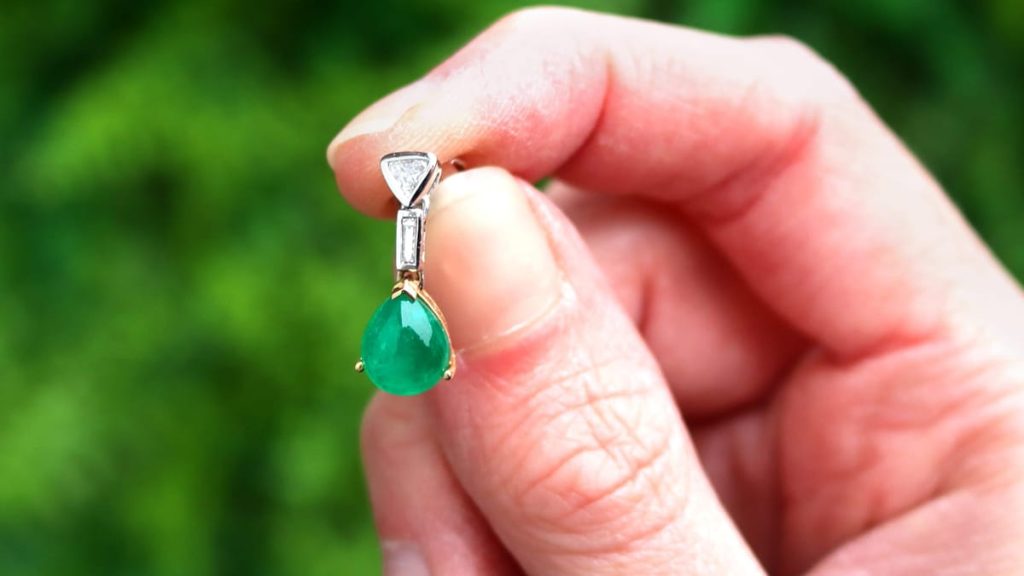There is an enormous variety of cuts for precious gemstones, and the trillion cut is among the most popular for diamonds. This page will comprehensively explain what a trillion-cut diamond is as well as explore the history of the cut and the various benefits and disadvantages it poses.
In the simplest terms, a trillion-cut diamond displays a triangular shape. Unlike other triangular gemstone cuts, the trillion cut features a complex and somewhat rounded system of facets throughout the table, crown, and girdle of the gemstone. Often, this can lead to the trillion-cut diamond appearing as a more rounded triangular shape, rather than a more typical angular triangle cut.
The curved version of the trillion cut, as described above, is mostly used for the feature stone in a piece of jewellery, while straight trillion cut stones – which present very angular triangle shapes – are often reserved for supporting stones on either side of a feature stone.
History of the Trillion Cut
Despite its cutting-edge appearance, the trillion cut has existed for sixty years. The Asscher family remain renowned artisans in the diamond industry, having started their family company in 1854. At the turn of the 20th century, they patented the iconic Asscher cut; a world first in exclusive patents which guaranteed no replication from rival diamond cutters until the mid-1940s.
During the Second World War, the Asscher family – being Jewish – were sent to concentration camps by the Nazis, along with the vast majority of their 500-strong staff of master diamond polishers. The patent on the Asscher cut expired during this time, and without anyone able to renew it, other jewellers began to use the cut and title, making it very difficult to distinguish the authenticity of an Asscher cut diamond from that point forward.
The ravages of the Holocaust left only ten Asscher family members and fifteen polishers alive to continue the Asscher business and reputation. Brothers Louis and Joop Asscher rebuilt the Asscher Diamond Company in Amsterdam as well as exploring new markets, swiftly regaining the company’s former reputation.
The Asschers introduced a cut they referred to as a ‘trilliant’ cut. This was a ‘triangular brilliant’ diamond cut, and it came at a time when many other jewellers were also experimenting with angular cuts. Leon Finker, a diamond cutter in New York, had discovered a way to achieve exceptional brilliance in a triangular cut during the 1960s. A close friend told him his creation would make him a billionaire, to which Finker replied ‘No. It will make me a trillionaire.’ Finker named the cut trillion for this reason, and his son, Marvin, patented the title in the 1970s.
At the same time, another large cutting factory in New York owned by Henry Meyer was also producing triangular brilliant diamonds, using the name ‘trilliant’. The trademark held by the Finkers was lost in 1986 after it had been deemed by a federal judge that there was not enough of a phonetic difference between trillion and trilliant for the patent to be valid. From that point forward, the Finker triangular brilliant cut diamonds were named Trielle diamonds, a registered trademark which allowed their brand to be easily authenticated.
Today, the terms ‘trillion’, ‘trillian’ and ‘trilliant’ can be used freely to describe any triangular brilliant cut diamond. The term Trielle is often used to describe generic trillion-cut diamonds, however this term is technically only applicable to diamonds crafted in the Finker patented cut.
Pros and Cons of the Trillion Cut
As is the case with any diamond cut, trillion-cut stones have benefits and disadvantages unique to them. It is important to consider these pros and cons before making a decision about what type of cut is correct for your needs.
One of the most valued features of the trillion cut is that it hides inclusions and dim areas of a diamond exceptionally well. The complex natural of its intricate facets creates an unparalleled brilliance and fire within the stone, which is not only a massively appealing feature in itself, but also creates the benefit of appearing to effectively eliminate any negatives that a diamond may have within its depths.
The drawback of this benefit is that a trillion-cut diamond needs to have a certain depth to its cut in order to properly display these appealing traits. Without depth, the diamond can appear flat and flaws will show up more easily.
Another benefit of the trillion cut is that its unique shape allows the stone to appear larger than other cuts in the same carat weight. A brilliant round cut, for example, is likely to appear smaller in size when compared directly with a trillion cut of the same carat weight due to the way the cut spreads out the table of the diamond.
This shape does also have faults, however, as the exposed pointed ends of the diamond leave it at a greater risk of being chipped, scratched, or otherwise damaged. This shape also requires very secure settings, with the v-shaped prong setting style being the most appropriate in order to maximalise light entering the stone whilst still balancing the level of security and protection that the cut requires.
The trillion-cut diamond is a comparatively recent development in the diamond jewellery industry, but its brilliance and beauty speak for itself, and its popularity is beyond question. While it has some disadvantages, it presents a unique shape which is highly valued around the world. Whether as an accent stone or the feature of a piece of jewellery, this gemstone cut is instantly recognisable understandably sought-after.










